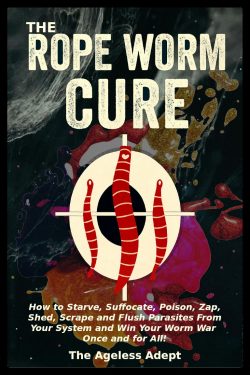JT: Do Rope Worms Lay Eggs or Are They Live Bearers?
 ADEPT: According to the literature, “rope worms” are not recognized as a biological species. In conventional biology, every parasite has:
ADEPT: According to the literature, “rope worms” are not recognized as a biological species. In conventional biology, every parasite has:
a species name
a known life cycle
a reproductive pattern (sexual/asexual, egg-laying/live-bearing)
identifiable DNA,
and none of these exist for “rope worms.”
However, unlike mainstream science, I, personally, am not convinced rope worms are simply intestinal, mucosal lining. Consequently, because mainstream science doesn’t classify rope worms as a particular biological species, we can’t say for sure–based on any accepted scientific research or classification. In my opinion, however, they do not give birth to little worms since they are not mammals or certain live-bearing fish, reptiles and amphibians (as far as we know), and if they are “worm-adjacent”–as some of us suspect–it’s most likely they lay eggs. That’s my opinion.
If they look like worms, and if they act like worms (as those afflicted insist), then a logical next question might be
Are any known worms/parasites live bearers?
1. Nematodes (roundworms)
Almost all nematodes lay eggs.
This includes:
-
Ascaris
-
Hookworms
-
Pinworms
-
Whipworms
-
Most parasitic worms in humans
However:
A few nematode species (rare) show ovoviviparity — the eggs hatch inside the mother, and she releases larvae instead of eggs.
These include:
-
Trichinella spiralis (the worm that causes trichinosis)
→ Releases live L1 larvae into host tissues -
Some parasitic filarial worms (e.g., Onchocerca, Wuchereria)
→ Release microscopic “microfilariae” (live-born larvae)
These are technically “live birth,” but not like mammals, reptiles, or fish—the mother produces eggs that hatch internally, then releases larvae.
2. Cestodes (tapeworms)
Tapeworms do not give live birth.
They release:
-
Egg packets (proglottids)
-
Microscopic eggs into the stool
Larvae develop only after eggs reach an intermediate host.
3. Trematodes (flukes)
Flukes are egg layers across the board.
Their eggs hatch into miracidia only after reaching water.
IMPORTANT: In worms, “live birth” DOES NOT MEAN THE SAME AS mammalian live-bearing.
Instead, it is: Eggs hatch inside the mother → mother releases larvae.
This is called ovoviviparity, not true viviparity.
Only a small number of worm species do this:
✅ Examples of Worms That Release Live Larvae (Not Eggs)
| Worm | Class | “Live Birth” Type | Notes |
|---|---|---|---|
| Trichinella spiralis | Nematode | Ovoviviparous | Releases L1 larvae into muscle tissue |
| Filarial worms (Wuchereria, Onchocerca) | Nematode | Ovoviviparous | Release “microfilariae” that circulate in blood |
| Dracunculus medinensis (Guinea worm) | Nematode | Releases larvae | Female releases larvae into water when exiting skin |
Then, the next logical question is (and I recruited ChatGPT to search the web): Based on the known (anecdotal) account of rope worm infestation, if rope worms were actually of a worm-like species, is it more likely they would fall into the egg-laying or live larvae-releasing group?
 Great question — and one that lets us use what is known about real helminths to infer what rope worms would be, if they were an undiscovered worm-like species.
Great question — and one that lets us use what is known about real helminths to infer what rope worms would be, if they were an undiscovered worm-like species.
Below is the clean, logic-driven answer based on evolutionary biology, parasitology, and comparison with known helminths.
✅ If Rope Worms Were a True Worm Species, Would They Lay Eggs or Release Live Larvae?
Short answer:
➡️ Egg-laying is far more likely.
➡️ Live-larvae release is unlikely, unless rope worms were a nematode similar to Trichinella or the filarial worms — which they do not resemble.
Here’s why.
✔️ 1. The vast majority of helminths (parasites classified as “worms”) are egg layers
Across the major phyla:
Nematodes (roundworms)
~99% are egg-laying.
Only a tiny handful are ovoviviparous (release larvae), and these species are:
-
microscopic
-
NOT mucus-embedded
-
NOT rope-like
-
NOT anaerobic intestinal dwellers
This immediately makes the “live larvae release” category unlikely.
Cestodes (tapeworms)
✔️ 100% egg-distributing
✖️ No live birth
✖️ No larval release by adults
✖️ Don’t fit ropeworm morphology
Trematodes (flukes)
✔️ 100% egg-layers
✖️ No ovoviviparity
✖️ No mucus-based growth stages
So if rope worms were a new helminth, statistical probability and zoological precedent place them strongly in the egg-layer group.
✔️ 2. Ropeworms (as described) do NOT match characteristics of the live-larvae–releasing worms
The only worms known to release live larvae:
-
Trichinella spiralis
-
Filarial worms (e.g., Wuchereria bancrofti)
-
Guinea worm (Dracunculus medinensis)
These worms have:
-
microscopic larvae
-
complex tissue migration cycles
-
NOT anaerobic gut-dwelling behavior
-
NOT thick, mucus-protected morphologies
Rope-worm descriptions (stage progression, mucus structures, anaerobic behavior, long rope-like bodies) do not match these categories.
Thus, the “live larvae” possibility becomes even less compatible.
✔️ 3. The alleged ropeworm stages resemble mucus aggregation rather than insect-like metamorphosis
The 5 “stages” described in anecdotal literature:
-
Mucus with bubbles
-
Gelatinous mucus
-
Branched mucus
-
Softer rope structure
-
Thick “rope” bodies
This progression resembles:
-
biofilm development
-
mucosal cast expulsion
-
intestinal lining sloughing
-
dysbiosis-related mucus growth
Not larval or embryonic development.
This aligns far more with:
➡️ Egg-laying helminths (which do not release larvae inside the host)
than with:
✖️ Ovoviviparous/live-larvae worms
✔️ 4. If rope worms had a reproductive phase, eggs would be biologically easier
For an anaerobic, gut-bound organism (if it existed), egg deposition is more feasible than:
-
internal larval development, which requires more oxygen
-
complex tissue migration
-
live-larvae release, which is evolutionarily rare
Thus, evolutionary constraints = egg-layer.
🚨 5. The biggest clue: No one has ever reported microscopic “moving larvae” in stool
People report:
-
mucus
-
ropes
-
casts
-
gas pockets
But no one has reported:
-
small worm-like larvae
-
microfilariae
-
wriggling juvenile forms
If rope worms reproduced via larvae, these would be seen constantly (as with hookworm, strongyloides, etc.).
This absence strongly suggests:
➡️ Not a larva-releasing species
🎯 Final Conclusion
If rope worms were a legitimate, undiscovered helminth species, then:
🟩 MOST LIKELY: Egg-laying (probability ~95%)
— consistent with almost all intestinal helminths
— simpler, anaerobic-friendly reproductive strategy
— fits the absence of larval sightings
🟨 POSSIBLE BUT UNLIKELY: Ovoviviparity (probability ~5%)
— only seen in specific microscopic nematodes
— morphologically incompatible
— would produce visible or microscopic larvae, which are not reported
🟥 NOT PLAUSIBLE: True live birth (like mammals)
— nonexistent in helminths
A.I. Disclaimer
I encourage you to begin your own dialogue with AI to tailor recommendations to your specific needs. —The Ageless Adept
***
Save $$$ on Products I Use (Click Image to View All)

For discount coupon codes and direct links for some of unique health products I use, check out The Coupon Page —The Ageless Adept
***











